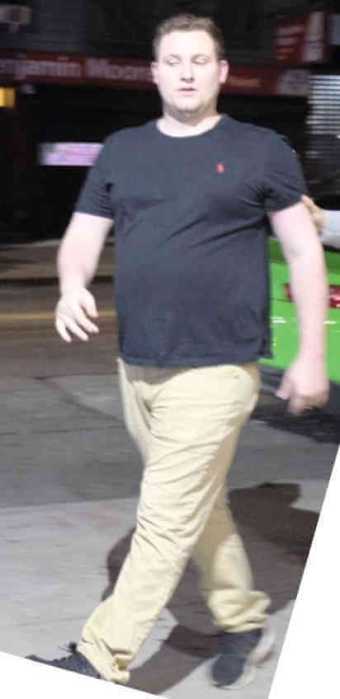Mayer Herskovic was sentenced to four years in jail, but that sentence was almost immediately stayed pending appeal. | JB NICHOLAS
A Brooklyn man was sentenced to four years in state prison for his role in the 2013 attack that left a black gay man blind in one eye. But less than three hours later, the defendant won a release from custody while his appeal is argued before a higher court.
After noting that Mayer Herskovic had not intended to cause serious physical injury to Taj Patterson during an early morning gang assault in Williamsburg, Judge Danny Chun said, “I did not find that in this particular defendant, but he was involved, he participated.”
Patterson, now 25, was set upon by roughly 20 men, some of whom belonged to a neighborhood patrol organized by the Satmar community. The Satmar are among the Hasidic sects of Orthodox Judaism. The men first pursued Patterson along Flushing Avenue in cars and on foot. Once caught, Patterson was punched, kicked, knocked to the ground, and had a thumb jammed in his eye.
Appeals court judge frees Mayer Herskovic after defense attorney scrambles to block incarceration
While no witness identified Herskovic, now 24, as the man who led the attack, his DNA was found on Patterson’s sneaker, which police recovered from the roof of a low building next to where the young man was assaulted. Patterson testified that the man who punched him in the face, jabbed a thumb in his eye, and kicked him in the face as he lay on the ground was the same man who pulled off his sneaker and tossed it on to the building.
Chun also sentenced Herskovic to one year in prison for unlawful imprisonment and 90 days in jail for menacing. Those sentences will be served concurrently with the four years for second-degree gang assault. Herskovic will have to serve six-sevenths of the sentence before being eligible for release. Chun also required that Herskovic have three years of post-release supervision.
Chun heard the non-jury trial and convicted Herskovic last year. He adjourned the sentencing twice and allowed Herskovic to stay out of jail while he had surgery.
On March 16, Stuart Slotnick, Herskovic’s attorney, asked that his client be sentenced to the minimum – three-and-a-half years in prison. Herskovic faced up to 15 years in prison.
“It was a crime that should not have occurred,” Herskovic said during his March 16 sentencing. “I wish I could take back what happened to Mr. Patterson so many years ago.”
Herskovic identified himself as a construction worker who has worked with “white, black, Spanish, gay, not gay” co-workers.
Patterson did not appear at the sentencing, but Tim Gough, a bureau chief and an assistant district attorney in the Brooklyn district attorney’s office who prosecuted the case with Tyear Middleton, also an assistant district attorney, spoke for him.
“Mr. Patterson has indicated that he would have like to see the maximum, but no amount of time would ever bring back his sense of peace or bring back his vision in his right eye,” Gough told Chun.
While Gough said that Patterson had expressed a desire to move on from the case, the effects of the assault remained in his life.
“One of the things he told me is he will never forget being told by a doctor that he would never regain the sight in his right eye,” Gough said.
The core of the case against Herskovic was that his DNA was found on Patterson’s sneaker. While Herskovic’s trial attorney, Israel Fried, attacked the reliability of the DNA testing, Chun was clearly unconvinced.
Slotnick immediately appealed the sentence before an appellate judge, asking for a stay of the sentence and that his client be released pending a result on that appeal. He argued that the evidence against his client was insufficient and that Herskovic was not a flight risk.
“Mayer Herskovic is an innocent man,” Slotnick told reporters as he was waiting to appear before an appellate judge after the sentencing. “We think the DNA evidence was completely and totally flawed.”
The sentencing was completed by roughly 11 a.m., and by 1:00 p.m. Slotnick joined reporters who had been waiting for news on his efforts and announced his client would be released by the end of the day.
“The stay has been granted so he’s going to be released,” Slotnick said. “We’re going to file an appeal so pending that appeal, he’s going to be out.”
The prosecution relied on high sensitivity DNA testing, which uses samples that are measured in picograms, or trillionths of a gram. The testing was done by the city medical examiner’s office. While many labs in the US do high sensitivity DNA testing, the city medical examiner is the only lab in the US that uses the method to produce evidence in criminal trials.
There could be as few as five or six skin cells in a picogram. The results are analyzed by software called the Forensic Statistical Tool, which produces a ratio indicating how likely it is that a particular individual contributed to the sample. The Forensic Statistical Tool is proprietary software used by the city medical examiner.
Four other men were initially charged in the attack. Charges were dropped against two and the other two pleaded guilty to misdemeanors.




































